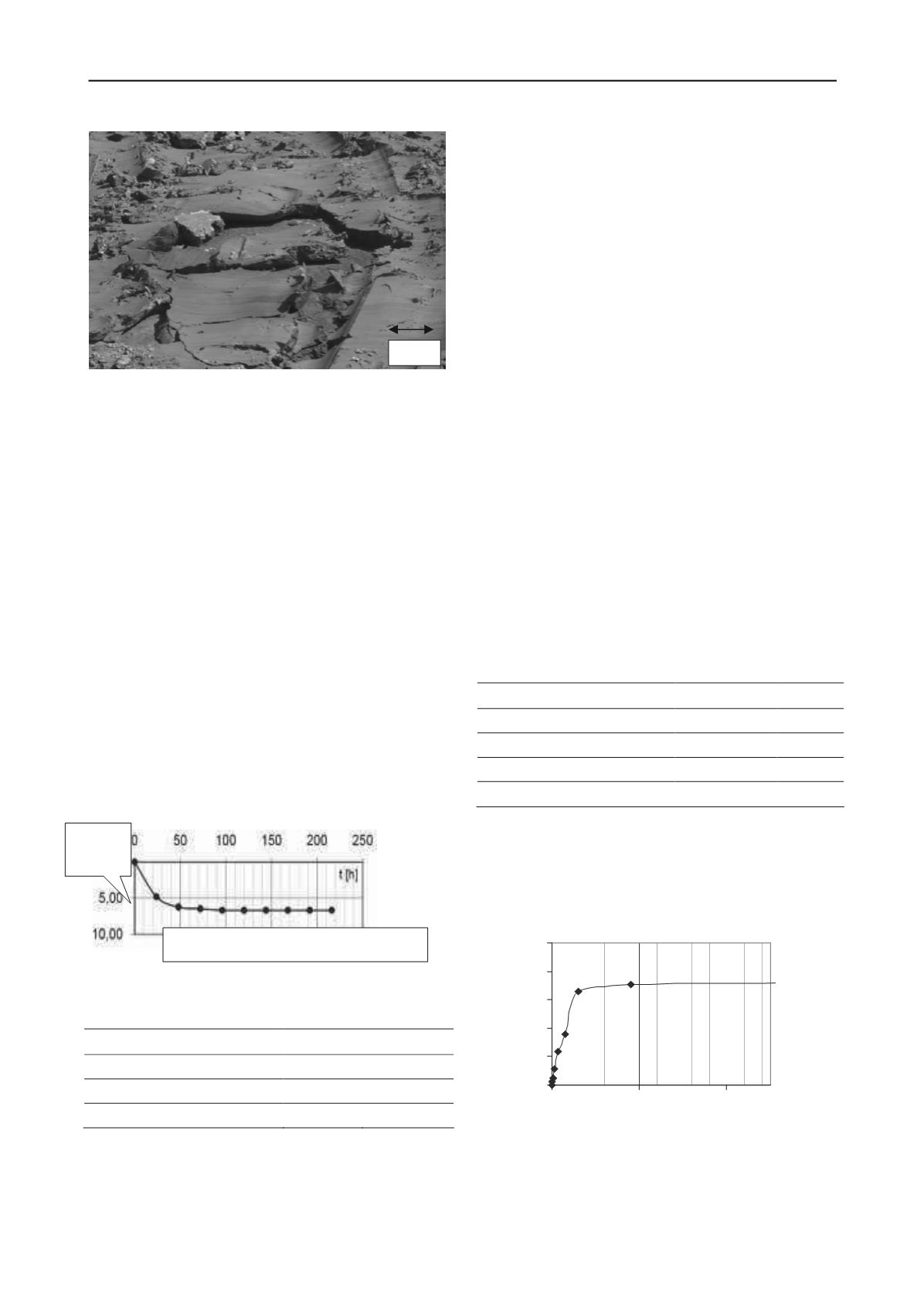
375
Technical Committee 101 - Session II /
Comité technique 101 - Session II
Figure 5. The natural process of clay drying after exposure of the
excavation's bottom, (after 2 hours) the superficial macrodisintegration
fully developed.
Detailed examination of the shrinkage and swelling phases
of expansive clays, as presented in this paper, were conducted
from the constructional substratum of the city of Bydgoszcz
situated in the northern region of Poland, (Niedzielski, Kumor
2009).
Expansive clays are characterised by extremely high numerical
values of expansive parameters against a background of other
tertiary clays in Poland. They should be classified in respect to
the contractibility range
(LL
–
SL)
= 82.1% > 50 %, as very
highly expansive soils.
1.2
Shrinkage phase examination
The soil contractibility examination is a determination
infrequently performed for practical purposes. The volumetric
shrinkage (V
s
) of expansive clay was examined according to
the following see Eq.:
V
s
= (V’ – V’’) / V’ (%)
(1)
where:
V’
–
soil sample initial volume [cm
3
],
V
’’
- final volume of the sample after drying [cm
3
].
Typical results of the shrinkage progress are presented in
Figure 6 and see Table 2.
Figure 6. A typical progress of expansive clay shrinkage over time.
Table 2. Same shrinkage parameters of Polish expansive clays
.
Parameter
Max.
Shrinkage time t
s
(
h)
50 -96
Volumetric shrinkage V
s
[%]
23-24
Shrinkage limit SL
[%]
18.2-18.9
The shrinkage examination results reveal losses in the massif
volume and a high sensitivity of expansive clays to changes in
humidity in a short time after the start of drying, see: Figure 5
and Figure 6.
The volume loss
V
s
for the shrinkage phase of the
expansive clay in the Northern Poland can be determined by
means of see Eq. 2:
V
s
= 0,783 * (w
o
–
w
k
) at w
k
> SL
(2)
where:
w
0
–
initial humidity,
[%]
w
k
–
final humidity
[%]
.
From a practical point of view, it is important to learn the
volumetric shrinkage values. The form of the function between
relative volumetric shrinkage (
V
s
) and humidity is linear for
expansive clay, with statistical significance
R
2
= 0.9545:
V
s
= -3,5731 + 0,783 * w
(3)
where:
V
s
–
relative volumetric shrinkage [%],
w
–
humidity, > w
s
[%].
In the process of drying and with humidity lowered by the
value of
w
=
(w
o
–
w
k
)
, the volume of the relative volumetric
shrinkage is important for forecasting post-consolidation
settlements of newly erected buildings, as well as for preventing
failures in buildings used for many years. It follows from
observations Kumor (2006), that differences in actual shrinkage
settlements under a damaged building amount to tens of
millimetres, Figure 1.
The parameters describing the shrinkage process, as well as
swelling, are individual
material features
of each expansive
soils.
1.3
Swelling phase
The swelling parameters of expansive clays were examined
using methods applied in soil mechanics laboratories.
Table 3. Swelling parameters of expansive clays.
Parameter
Max.
Medium
Swelling pressure p
c
(kPa)
1200
200-400
Swelling humidity w
c
[%]
137.0
80-99
Contractility range
(w
L
–
w
s
) [%]
130.5
99.1
Swelling index v
p
[%]
62.0
21.7
The following values were measured: swelling humidity -
w
c
, swelling index
–
V
p
, according to Vasiliev, swelling
pressure
–
p
c
, in a consolidometer, swelling time - t
p
.
Exemplary testing results are presented in Table 3, Figure 7, 8.
Figure 7. Dependence of the swelling index -
Vp,
on the expansive
clay swelling time -
t
.
50 mm
Shrinkage
V
s
Laboratory test
–
shrinkage V
s
= f(t)
0,0
2,0
4,0
6,0
8,0
10,0
0
200
400
t [min]
Vp (%)
w=45,33


